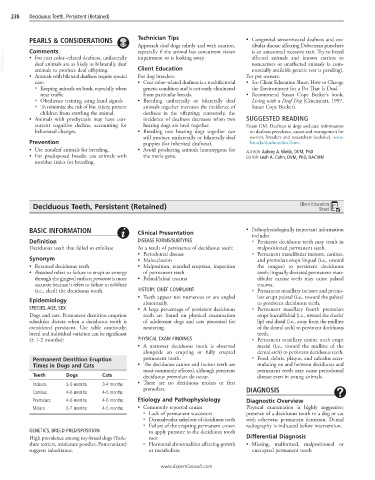Page 533 - Cote clinical veterinary advisor dogs and cats 4th
P. 533
238 Deciduous Teeth, Persistent (Retained)
PEARLS & CONSIDERATIONS Technician Tips • Congenital sensorineural deafness and ves-
Approach deaf dogs calmly and with caution, tibular disease affecting Doberman pinschers
Comments
VetBooks.ir • For coat color–related deafness, unilaterally impairment or is looking away. affected animals and known carriers to
is an autosomal recessive trait. Try to breed
especially if the animal has concurrent vision
noncarriers or unaffected animals (a com-
deaf animals are as likely as bilaterally deaf
Client Education
mercially available genetic test is pending).
animals to produce deaf offspring.
• Animals with bilateral deafness require special For dog breeders: For pet owners:
care: • Coat color–related deafness is a multifactorial • See Client Education Sheet: How to Change
○ Keeping animals on leash, especially when genetic condition and is not easily eliminated the Environment for a Pet That Is Deaf.
near traffic from particular breeds. • Recommend Susan Cope Becker’s book,
○ Obedience training using hand signals • Breeding unilaterally or bilaterally deaf Living with a Deaf Dog (Cincinnati, 1997,
○ To minimize the risk of bite injury, prevent animals together increases the incidence of Susan Cope Becker).
children from startling the animal. deafness in the offspring; conversely, the
• Animals with presbycusis may have con- incidence of deafness decreases when two SUGGESTED READING
current cognitive decline, accounting for hearing dogs are bred together. Strain GM: Deafness in dogs and cats: information
behavioral changes. • Breeding two hearing dogs together can on deafness prevalence, causes and management for
still produce unilaterally or bilaterally deaf owners, breeders and researchers (website). www.
Prevention puppies (for inherited deafness). lsu.edu/deafness/deaf.htm.
• Use nondeaf animals for breeding. • Avoid producing animals homozygous for AUTHOR: Aubrey A. Webb, DVM, PhD
• For predisposed breeds: use animals with the merle gene. EDITOR: Leah A. Cohn, DVM, PhD, DACVIM
nonblue irides for breeding.
Deciduous Teeth, Persistent (Retained) Client Education
Sheet
BASIC INFORMATION Clinical Presentation • Pathophysiologically important information
includes
Definition DISEASE FORMS/SUBTYPES ○ Persistent deciduous teeth may result in
Deciduous teeth that failed to exfoliate As a result of persistence of deciduous teeth: malpositioned permanent teeth.
• Periodontal disease ○ Permanent mandibular incisors, canines,
Synonym • Malocclusion and premolars erupt lingual (i.e., toward
• Retained deciduous teeth • Malposition, retarded eruption, impaction the tongue) to persistent deciduous
• Retained refers to failure to erupt or emerge of permanent teeth teeth; lingually deviated permanent man-
through the gingival surface; persistent is more • Palatal/labial trauma dibular canine teeth may cause palatal
accurate because it refers to failure to exfoliate trauma.
(i.e., shed) the deciduous tooth. HISTORY, CHIEF COMPLAINT ○ Permanent maxillary incisors and premo-
• Teeth appear too numerous or are angled lars erupt palatal (i.e., toward the palate)
Epidemiology abnormally. to persistent deciduous teeth.
SPECIES, AGE, SEX • A large percentage of persistent deciduous ○ Permanent maxillary fourth premolars
Dogs and cats. Permanent dentition eruption teeth are found on physical examination erupt buccal/labial (i.e., toward the cheek/
schedules dictate when a deciduous tooth is of adolescent dogs and cats presented for lip) and distal (i.e., away from the midline
considered persistent. Use table cautiously; neutering. of the dental arch) to persistent deciduous
breed and individual variation can be significant teeth.
(± 1-2 months): PHYSICAL EXAM FINDINGS ○ Permanent maxillary canine teeth erupt
• A narrower deciduous tooth is observed mesial (i.e., toward the midline of the
alongside an erupting or fully erupted dental arch) to persistent deciduous teeth.
Permanent Dentition Eruption permanent tooth. ○ Food, debris, plaque, and calculus accu-
Times in Dogs and Cats • The deciduous canine and incisor teeth are mulating on and between deciduous and
most commonly affected, although persistent permanent teeth may cause periodontal
Teeth Dogs Cats deciduous premolars do occur. disease even in young animals.
Incisors 3-5 months 3-4 months • There are no deciduous molars or first
premolars. DIAGNOSIS
Canines 4-6 months 4-5 months
Premolars 4-6 months 4-6 months Etiology and Pathophysiology Diagnostic Overview
Molars 5-7 months 4-5 months • Commonly reported causes Physical examination is highly suggestive;
○ Lack of permanent successors presence of a deciduous tooth in a dog or cat
○ Dentoalveolar ankylosis of deciduous teeth with otherwise permanent dentition. Dental
○ Failure of the erupting permanent crown radiography is indicated before intervention.
GENETICS, BREED PREDISPOSITION to apply pressure to the deciduous tooth
High prevalence among toy-breed dogs (York- root Differential Diagnosis
shire terriers, miniature poodles, Pomeranians) ○ Hormonal abnormalities affecting growth • Missing, malformed, malpositioned or
suggests inheritance. or metabolism unerupted permanent tooth
www.ExpertConsult.com

